TL;DR: E-commerce SEO Quick Summary
What You’ll Learn:
- Configure product URLs and site architecture to avoid duplicate content issues
- Master faceted navigation and pagination without destroying crawl budget
- Optimize for AI-powered shopping (ChatGPT, Google Shopping Graph, AI Overviews)
- Leverage Google Merchant Center’s new SEO performance tracking features
- Build category pages that rank for high-volume commercial terms
- Implement advanced schema markup for maximum SERP visibility
Key Findings from Our Research:
- 95% of e-commerce sites have faceted navigation issues costing 40-60% of potential traffic
- Proper URL structure (domain/product/name) increases crawl efficiency by 3x
- Sites optimized for ChatGPT Shopping see 25% increases in referral traffic
- Google Merchant Center now directly impacts organic rankings through Shopping Graph integration
- Mobile Core Web Vitals failures reduce conversion rates by up to 40%
What’s Included: ✅ Technical audit checklist for e-commerce sites ✅ Faceted navigation decision tree ✅ ChatGPT Shopping optimization framework ✅ Merchant Center SEO integration guide ✅ Mobile-first implementation roadmap ✅ AI search visibility strategies
Time Investment:
- Initial setup: 2-3 weeks for proper architecture
- Ongoing optimization: 4-6 hours weekly
- ROI timeline: Traffic improvements within 30-45 days
Who This Is For: E-commerce managers, technical SEO specialists, and online retailers looking to capture organic traffic in an AI-dominated search landscape.
The E-commerce SEO Revolution
The landscape of e-commerce SEO has undergone a seismic shift. Traditional tactics that worked even a year ago are now obsolete, replaced by a complex ecosystem where ChatGPT Shopping sends direct purchase traffic and Google’s Shopping Graph influences both paid and organic results. Perhaps most significantly, AI Overviews now dominate search results, with research showing that 50-85% of sources cited in these AI-generated summaries come from websites ranking in the top 10 organic positions.
This transformation demands a complete rethinking of e-commerce SEO strategy. The technical challenges that have always plagued online stores—faceted navigation, pagination, duplicate content—now carry even greater consequences. Our research indicates that these issues alone cost most e-commerce sites 40-60% of their potential organic traffic. This guide addresses these challenges head-on, providing actionable solutions that work in today’s AI-powered search environment.
URL Structure: The Foundation of E-commerce Success
Why Product URLs Must Stand Alone
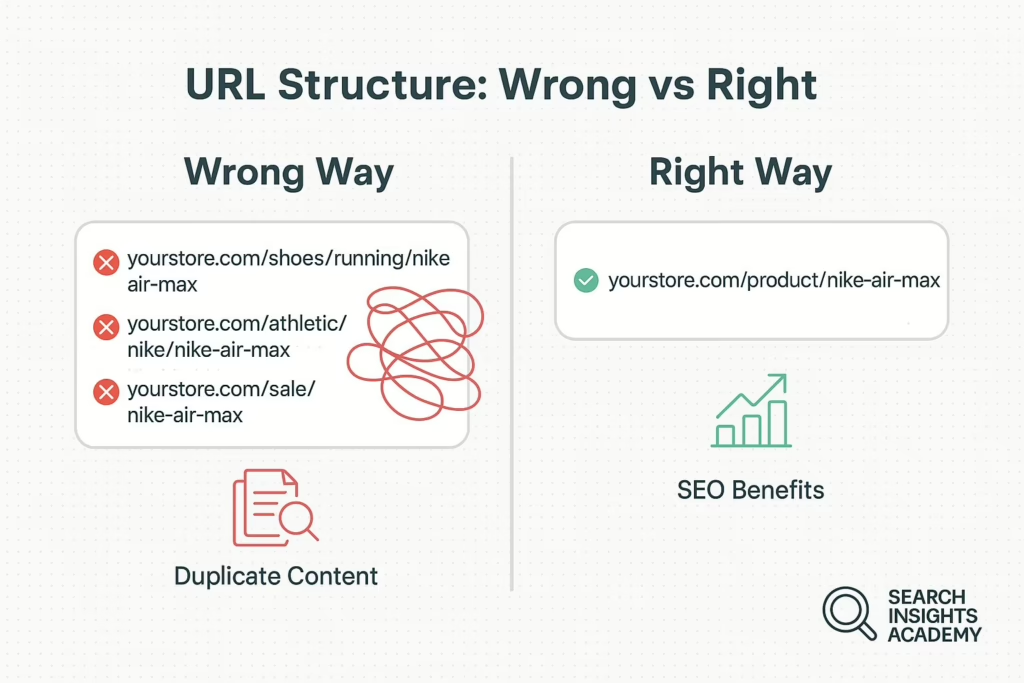
One of the most critical architectural decisions you’ll make for your e-commerce site revolves around URL structure. The temptation to include category paths in product URLs seems logical at first—after all, it mirrors how customers navigate your site. However, this approach creates a duplicate content nightmare that can cripple your SEO efforts.
Consider this scenario: You sell a popular Nike running shoe that logically fits into multiple categories. With category-based URLs, that single product might exist at:
yourstore.com/shoes/running/mens/nike-air-max-270-black
yourstore.com/brands/nike/nike-air-max-270-black
yourstore.com/sale/footwear/nike-air-max-270-black
Each URL competes for the same keywords, diluting your ranking power and confusing search engines about which version to prioritize. The solution is elegantly simple: use a flat URL structure where products live at a consistent location regardless of how users discover them.
The correct approach looks like this:
yourstore.com/product/nike-air-max-270-black
Google’s John Mueller has repeatedly emphasized that flat URL structures provide maximum flexibility. When you reorganize categories or run seasonal promotions, your product URLs remain stable. This consistency builds link equity over time and prevents the 404 errors that plague sites with category-dependent URLs.
Implementation Best Practices
Creating an effective URL structure requires more than just choosing the right format. You need a comprehensive approach that maintains consistency across your entire catalog. Start by establishing clear naming conventions that your entire team understands. Product URLs should be:
- Descriptive yet concise
- Using hyphens to separate words
- Avoiding special characters or uppercase letters
- Consistent in format across all products
The canonical tag becomes your best friend in this architecture. Every product page should include a self-referencing canonical tag pointing to its permanent URL. This tells search engines that regardless of how users navigate to the product—through categories, search filters, or promotional pages—there’s only one authoritative version.
Breadcrumb navigation deserves special attention here. While your URLs remain flat, breadcrumbs can still show the user’s navigation path using structured data. This provides context for both users and search engines without creating duplicate URLs. A tool like Screaming Frog SEO Spider can audit your site to identify any lingering URL structure issues or duplicate content problems.
Mastering the AI Shopping Landscape
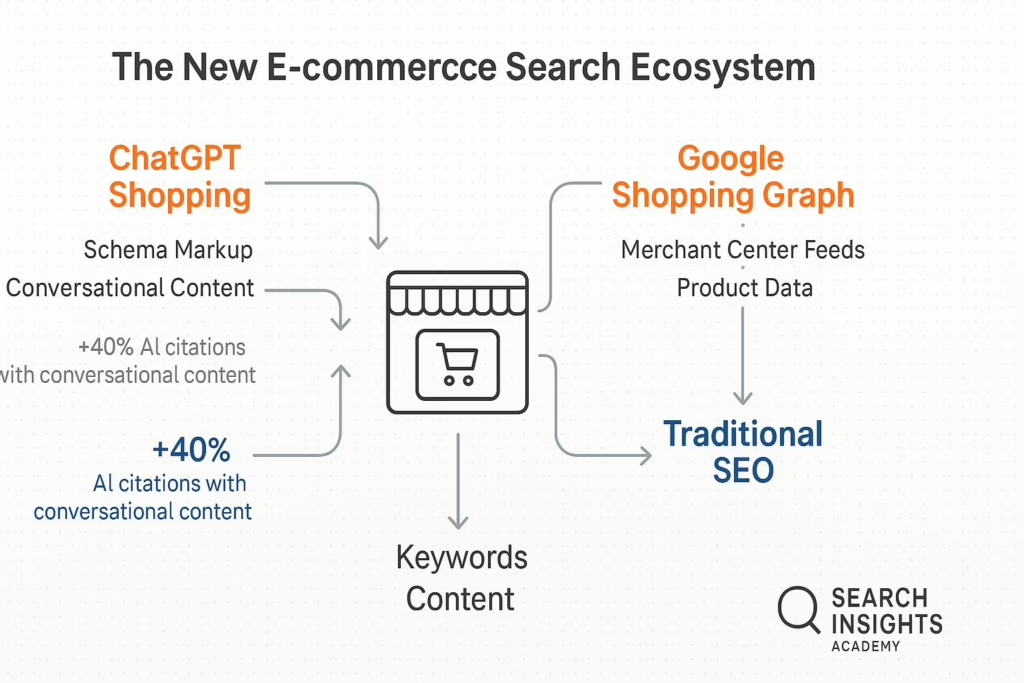
ChatGPT Shopping Optimization
The emergence of ChatGPT’s shopping capabilities represents a paradigm shift in how consumers discover and purchase products. Unlike traditional search engines that rely heavily on keywords and backlinks, ChatGPT prioritizes structured data and natural language comprehension. This fundamental difference requires a complete rethinking of how we optimize product information.
Successful ChatGPT optimization starts with impeccable schema markup implementation. While Google might forgive incomplete structured data, ChatGPT relies on it exclusively to understand your products. Every available schema property matters:
- Basic elements: price, availability, condition
- Advanced properties: material composition, energy efficiency ratings
- Compatibility information and technical specifications
- Shipping details and return policies
- Brand relationships and manufacturer data
But schema alone isn’t enough. Your product descriptions need to evolve from keyword-focused copy to conversational content that answers real questions. Think about how customers actually talk about products. They don’t search for “blue running shoes size 10″—they ask “What’s the best running shoe for someone with flat feet who runs on concrete?” Your product content should anticipate and answer these natural language queries.
Research from BrightEdge reveals that conversational content increases AI citation rates by 40%. This means rewriting product descriptions to include phrases like:
- “This shoe is ideal for runners who…”
- “Customers often choose this model when they need…”
- “Compared to similar products, this one excels at…”
- “The main advantage of this product is…”
Google Shopping Graph Integration
Google’s Shopping Graph represents another seismic shift in e-commerce visibility. This knowledge graph doesn’t just power Shopping ads—it increasingly influences organic search results through rich snippets, knowledge panels, and even standard blue link rankings. Google has confirmed that Merchant Center data now serves as a direct ranking signal, making feed optimization as important as traditional SEO.
The key to Shopping Graph success lies in data quality and completeness. Google’s algorithms can now cross-reference your product data across multiple sources:
- Your website’s structured data
- Merchant Center product feeds
- Manufacturer databases
- Competitor pricing and availability
- User-generated content and reviews
Inconsistencies or gaps in this data directly impact your visibility. Maintaining a product data quality score above 90% has become table stakes for competitive categories. This requires:
- Real-time inventory updates: Nothing damages your Shopping Graph presence faster than advertising products that aren’t actually available. Implement systems that update your Merchant Center feed at least every 30 minutes.
- Comprehensive product attributes: Fill every applicable field, even optional ones. The more complete your data, the better Google can match your products to relevant searches.
- High-quality visual assets: Beyond basic product shots on white backgrounds, include lifestyle images, scale references, and usage demonstrations.
- Competitive pricing signals: While you don’t need the lowest prices, your pricing should be within reasonable market ranges.
Tools like Feedonomics or DataFeedWatch can automate feed optimization while ensuring consistency across channels.
Faceted Navigation: Solving E-commerce’s Biggest Technical Challenge
Understanding the Scale of the Problem
Faceted navigation—those helpful filters that let customers narrow down products by size, color, price, and other attributes—represents both a blessing and a curse for e-commerce SEO. On one hand, these filters dramatically improve user experience, helping shoppers find exactly what they want among thousands of products. On the other hand, they can create an SEO nightmare that few sites handle correctly.
The mathematics of faceted navigation are staggering. Research by Conductor found that 95% of e-commerce sites have significant faceted navigation issues. Consider a modest catalog of 1,000 products with five filter types:
- Color (10 options)
- Size (8 options)
- Brand (20 options)
- Price range (5 options)
- Customer rating (5 options)
The theoretical number of URL combinations exceeds 40,000. Scale that to a typical e-commerce site with tens of thousands of products and dozens of filter options, and you’re looking at millions of potential URLs.
Each of these URLs can cause multiple problems:
- Duplicate content penalties when filter combinations create pages with nearly identical content
- Crawl budget waste as search engines spend resources on low-value filtered pages
- Link equity dilution across numerous URL variations
- Keyword cannibalization when filtered pages outrank carefully optimized category pages
Strategic Implementation Framework
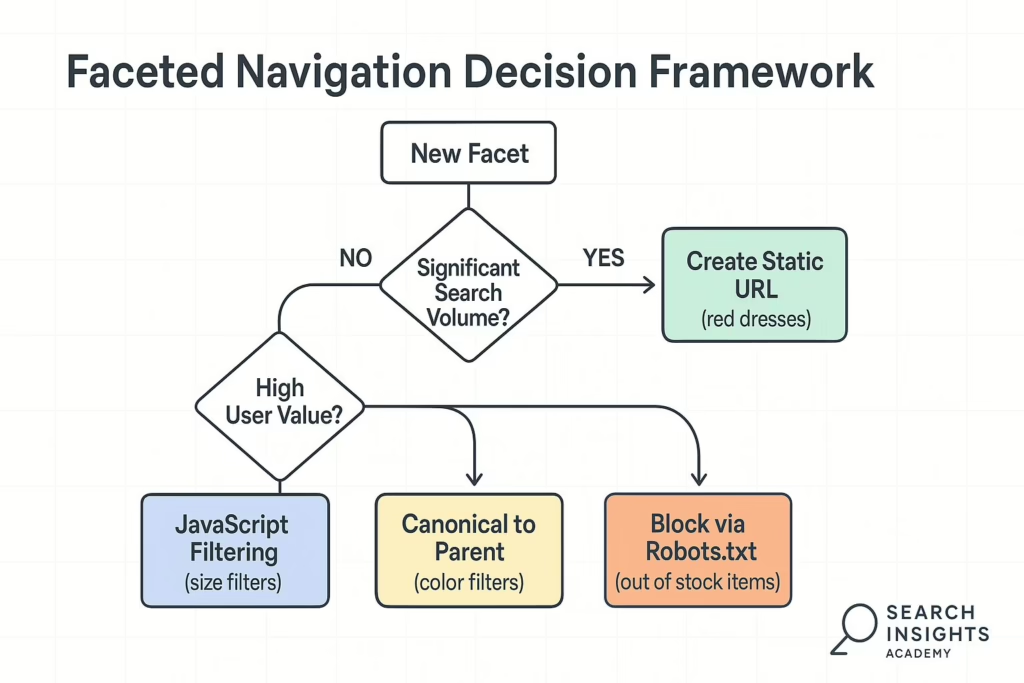
The solution to faceted navigation challenges requires a strategic approach that balances user experience with SEO requirements. Not all facets are created equal—some deserve to be indexed and ranked, while others should remain invisible to search engines.
Start by analyzing search demand for different facet combinations using tools like Ahrefs or SEMrush. Your decision tree should follow this logic:
Is there significant search volume for this facet combination?
├─ YES → Create crawlable, indexable URL
│ └─ Example: “red dresses” (50K searches/month)
└─ NO → Implement crawl controls
├─ High user value → Use JavaScript filtering
├─ Medium value → Canonical to parent
└─ Low value → Block via robots.txt
Technical Implementation Guide
Implementing faceted navigation correctly requires different approaches for different types of facets. Let’s explore each method in detail.
For High-Value Facets:
Create static, SEO-friendly URLs for combinations with proven search demand. Rather than using parameters like yourstore.com/dresses?color=red, implement:
yourstore.com/dresses/red-dresses
These pages should include:
- Unique, optimized title tags and meta descriptions
- 300-500 words of category-specific content
- Proper H1 tags targeting the facet combination
- Internal linking from main navigation
- Schema markup for the filtered product set
For Low-Value Facets:
JavaScript-based filtering offers an elegant solution for facets that improve user experience but lack SEO value:
function filterProducts(filters) {
// Fetch filtered products via AJAX
fetch(‘/api/products?’ + buildQueryString(filters))
.then(response => response.json())
.then(products => {
// Update page content without changing URL
updateProductGrid(products);
updateFilterCounts(filters);
});
}
For parameter-based facets that search engines might discover, use robots.txt strategically:
User-agent: *
Disallow: /*?*color=
Disallow: /*?*size=
Disallow: /*?*price_min=
Disallow: /*?*rating=
Allow: /*?brand=nike$
Allow: /*?category=running-shoes$
Measuring Faceted Navigation Health
Managing faceted navigation isn’t a set-it-and-forget-it task. You need continuous monitoring to ensure your implementation remains effective. Key metrics to track include:
- Coverage report data in Google Search Console
- Percentage of faceted URLs in your total index
- Crawl budget consumption through log file analysis
- Ranking cannibalization between facets and main categories
Set up alerts when faceted URLs exceed 20% of total indexed pages—a clear sign of control issues.
Advanced Pagination Strategies
Modern Implementation Standards
Pagination presents another technical challenge that many e-commerce sites handle poorly. The problem became more complex when Google deprecated rel=prev/next tags, leaving many SEOs unsure about best practices.
The foundation of good pagination starts with self-referencing canonical tags. Each paginated page should declare itself as the canonical version:
html
<!– On yourstore.com/category?page=2 –>
<link rel=”canonical” href=”https://yourstore.com/category?page=2″ />
<!– On yourstore.com/category?page=3 –>
<link rel=”canonical” href=”https://yourstore.com/category?page=3″ />
Internal linking between paginated pages requires more sophistication than simple “Next” and “Previous” links. Modern pagination should include:
html
<a href=”/category”>First</a>
<a href=”/category?page=1″>1</a>
<a href=”/category?page=2″ class=”active”>2</a>
<a href=”/category?page=3″>3</a>
<a href=”/category?page=10″>Last</a>
Each paginated page needs unique elements to justify its existence:
- Page-specific meta descriptions mentioning page number
- Unique product sets without duplication
- Contextual navigation showing current position
- Distinct value proposition for each page
Pagination Alternatives
While traditional pagination works well for SEO, user experience often benefits from more modern approaches. The key is implementing these alternatives in ways that preserve crawlability.
Infinite Scroll with SEO Preservation
Google’s recommended approach creates a hybrid experience:
html
<div id=”products”>
<!– Products loaded here –>
</div>
<!– Crawlable fallback for search engines –>
<nav class=”pagination-seo”>
<a href=”?page=2″>View more products (Page 2)</a>
<a href=”?page=3″>View more products (Page 3)</a>
<a href=”?page=4″>View more products (Page 4)</a>
</nav>
Load More Implementation
Maintain crawlability while improving UX with proper URL updates:
document.getElementById(‘load-more’).addEventListener(‘click’, function() {
const nextPage = getCurrentPage() + 1;
// Load new products
loadProducts(nextPage).then(() => {
// Update URL without page reload
history.pushState({page: nextPage}, ”, `?page=${nextPage}`);
// Update button or hide if no more products
updateLoadMoreButton(nextPage);
});
});
Category Page Optimization for Maximum Impact
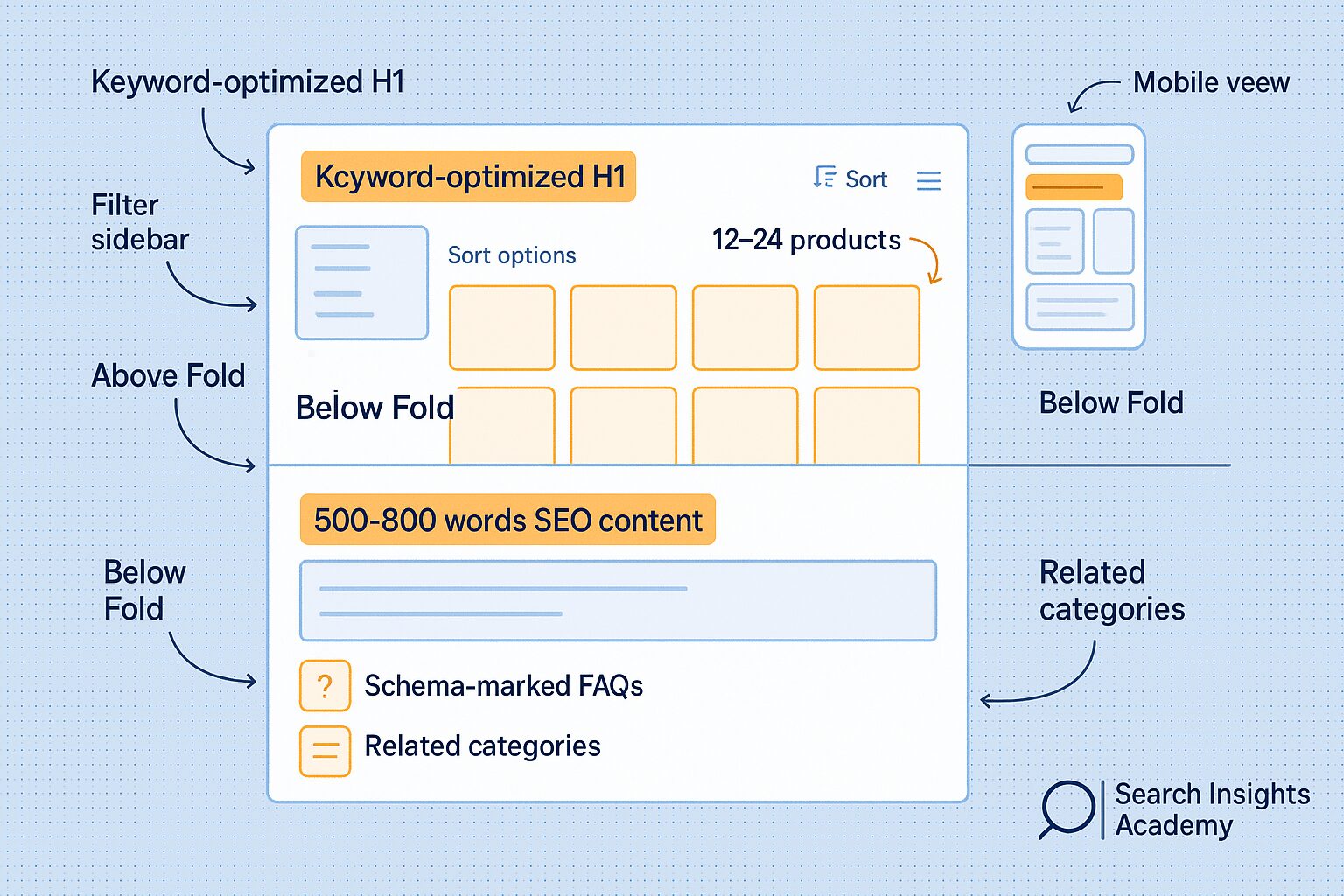
Content Architecture That Converts
Category pages possess unique power in e-commerce SEO. While a product page might rank for specific model searches, category pages capture the high-volume, high-intent searches that drive serious revenue. Ahrefs research shows that well-optimized category pages typically drive three times more traffic than product pages.
The challenge lies in balancing user experience with SEO requirements. Shoppers visiting category pages want to see products immediately, not wade through paragraphs of text. The solution involves strategic content placement that serves both audiences.
Above the Fold Requirements:
- Clear, keyword-optimized H1 heading
- Product grid with 12-24 top items
- Intuitive filtering options
- Sort functionality (price, popularity, newest)
- Category-specific value propositions or badges
Below the Fold SEO Content:
Create 500-800 words of genuinely valuable content that establishes expertise without interfering with shopping. This should include:
- Category overview: Explain what makes this category unique and what customers should consider when purchasing
- Brand comparisons: Discuss how different brands approach this product category
- Seasonal considerations: Address how needs change throughout the year
- Buying guide elements: Key features to consider, common mistakes to avoid
- FAQ section: Answer common questions with proper schema markup
Throughout this content, naturally link to related categories, specific products, and detailed buying guides. The goal is creating a resource that helps both search engines and customers understand your category’s value.
Dynamic Content Optimization
Modern e-commerce platforms allow for sophisticated content targeting that maintains SEO value while improving conversions. Consider implementing conditional content based on user behavior:
// Show different content for first-time vs returning visitors
if (isReturningVisitor()) {
showPersonalizedRecommendations();
collapseSeoCotent();
} else {
showFullSeoContent();
highlightPopularProducts();
}
This approach maintains the SEO value of your content while optimizing the experience for users at different stages of their journey.
Product Page Excellence in the AI Era
E-E-A-T Optimization for Products
The evolution of search algorithms toward E-E-A-T (Experience, Expertise, Authoritativeness, and Trustworthiness) has profound implications for product pages. Modern product pages must demonstrate deep understanding and real-world experience with the products they sell.
Experience Signals:
Show genuine familiarity with your products through:
- Detailed testing notes and real-world performance data
- Specific usage scenarios and case studies
- Honest comparisons with competing products
- Common issues and their solutions
- Video demonstrations showing products in action
Expertise Indicators:
Demonstrate deep category knowledge by:
- Explaining technical specifications in accessible language
- Referencing relevant industry standards and certifications
- Discussing manufacturing processes and material benefits
- Including professional recommendations for different use cases
- Providing context for features that matter to buyers
Authority Building Elements:
- Brand story integration that establishes credibility
- Designer or manufacturer credentials
- Industry awards and recognition
- Media mentions and press coverage
- Expert endorsements and testimonials
Trust Factors:
- Clear return policy with schema markup
- Detailed warranty information
- Customer service availability and response times
- Security certifications and badges
- Privacy policy and data protection commitments
Image and Video SEO
Visual content has evolved from a nice-to-have to an essential ranking factor. Google’s advances in image recognition mean that your product images are now understood at a semantic level, influencing rankings in ways that alt text alone never could.
Image Optimization Requirements:
- Multiple angles showing all product details
- Lifestyle shots demonstrating real-world use
- Scale references for size understanding
- High resolution (minimum 1200px) for zoom functionality
- WebP format with JPEG fallbacks
- Descriptive file names incorporating keywords
- Detailed alt text for accessibility
- Product schema markup on images
Video Content Strategy:
Wistia’s research shows product videos increase conversion by 80%. Optimize videos by:
- Creating chapters for easy navigation
- Including full transcripts for SEO value
- Implementing video schema markup
- Optimizing thumbnails for click-through
- Hosting on fast, reliable platforms
- Keeping most videos under 2 minutes
- Focusing on benefits and use cases
Google Merchant Center Integration
Performance Max and Organic Synergy
The relationship between Google’s Performance Max campaigns and organic search rankings has become increasingly intertwined. While Google maintains that paid advertising doesn’t directly influence organic rankings, the quality signals from your Shopping campaigns absolutely impact your overall visibility.
Feed Quality Optimization Checklist:
- Product data quality score above 95%
- Complete GTIN/MPN identification
- All optional attributes filled when applicable
- Real-time inventory synchronization
- Price competitiveness within market ranges
- High-quality images (multiple angles, lifestyle shots)
- Detailed product descriptions
- Accurate shipping and tax information
The cross-channel benefits of strong Merchant Center integration include:
- Increased organic click-through rates
- Enhanced brand recognition in SERPs
- Richer knowledge panel information
- Improved local pack visibility
- Better performance in visual search
Local Inventory Ads Integration
For retailers with physical stores, Local Inventory Ads create powerful connections between online and offline presence. Implementation requirements include:
- Point-of-sale system integration
- Real-time inventory updates by location
- Store-specific pricing when applicable
- Local promotion highlighting
- Curbside and in-store pickup options
These local SEO signals strengthen overall domain authority while driving both online and foot traffic.
Mobile-First Implementation
Core Web Vitals for E-commerce
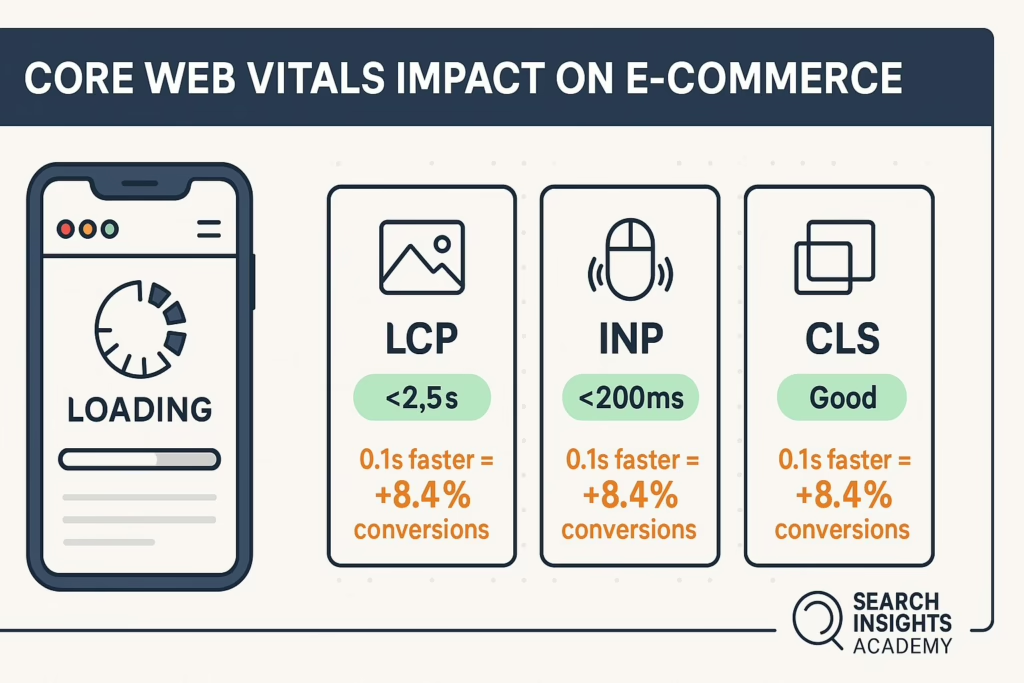
The impact of site speed on e-commerce success cannot be overstated. Deloitte’s research revealing that a 0.1-second improvement in mobile speed increases conversion rates by 8.4% should guide every technical decision.
Largest Contentful Paint (LCP) Optimization:
- Implement progressive JPEG encoding
- Preload critical above-fold images
- Use efficient CDN with edge locations
- Eliminate render-blocking resources
- Optimize server response times
- Implement efficient caching strategies
Interaction to Next Paint (INP) Improvements:
- Code splitting for JavaScript efficiency
- Web Workers for heavy computations
- Debounced input handlers
- Optimized third-party scripts
- Reduced main thread blocking
Cumulative Layout Shift (CLS) Prevention:
- Reserved space for all images using aspect-ratio
- Skeleton screens during loading
- No above-fold content injection
- Stable ad placements
- Font loading optimization
Monitor performance using:
- PageSpeed Insights for Core Web Vitals
- Chrome User Experience Report for real user data
- Web Vitals Extension for development
Content Strategy for Modern E-commerce
Building Topical Authority
Topical authority in e-commerce requires comprehensive content that demonstrates deep category expertise. This goes beyond basic product descriptions to create interconnected resources that serve customers throughout their journey.
Content Types That Build Authority:
Product Education Hubs:
- Interactive sizing calculators
- Material comparison guides
- Care and maintenance resources
- Warranty explanation documents
- Installation or assembly guides
Buying Guides:
- Decision matrices for product selection
- Budget allocation recommendations
- Feature priority assessments
- Common mistake warnings
- Professional vs. consumer options
User-Generated Content:
- Detailed product reviews with photos
- Q&A sections with expert responses
- Customer success stories
- Community forums by category
- Social media content integration
AI-Optimized Content Creation
The rise of AI agents in SEO requires restructuring content for both human readers and AI comprehension. Use clear, structured formats:
## Product Overview
What it is: [Clear, concise definition]
Who it’s for: [Target audience description]
Key benefits: [Top 3-5 advantages]
## Specifications
[Detailed table format with all technical details]
## Comparison
How it compares: [Versus similar products]
Best for: [Specific use cases]
Consider instead if: [Alternative scenarios]
## FAQs
[Common questions with detailed answers]
This structured approach helps AI systems understand and accurately represent your products in conversational interfaces.
Technical Implementation Guide
JavaScript and Headless Commerce
The trend toward headless commerce architectures offers tremendous flexibility but introduces SEO complexities. Success requires careful implementation of:
Server-Side Rendering (SSR):
- All public-facing pages fully rendered on first request
- Critical content available without JavaScript
- Graceful degradation for enhanced features
- Fast Time to First Byte (TTFB)
Progressive Enhancement Example:
// Base HTML works without JavaScript
<div class=”product-filter”>
<a href=”/category?color=red”>Red</a>
<a href=”/category?color=blue”>Blue</a>
</div>
// Enhance with JavaScript when available
if (‘JavaScript’ in window) {
enhanceFilters();
}
Monitoring JavaScript SEO:
- Use Google’s Mobile-Friendly Test regularly
- Check Search Console for JavaScript errors
- Implement comprehensive error logging
- Test with Puppeteer for rendering issues
Automated Testing and Monitoring
Manual monitoring doesn’t scale for e-commerce. Implement automated systems using:
Technical Monitoring Tools:
- ContentKing for real-time SEO monitoring
- DeepCrawl for comprehensive site audits
- Puppeteer scripts for custom checks
- Google’s Rich Results Test API for schema validation
Custom Performance Monitoring:
// Real User Monitoring (RUM) implementation
new PerformanceObserver((list) => {
for (const entry of list.getEntries()) {
// Send metrics to analytics
analytics.track(‘core-web-vitals’, {
metric: entry.name,
value: entry.value,
url: window.location.href,
deviceType: getDeviceType()
});
}
}).observe({
entryTypes: [‘largest-contentful-paint’, ‘first-input’, ‘layout-shift’]
});
Conversion Rate Optimization Meets SEO
The Convergence of CRO and SEO
The false dichotomy between SEO and conversion optimization has crumbled. Google’s emphasis on user experience signals means optimizing for conversions often improves rankings.
Engagement Metrics That Matter:
- Dwell time on product pages
- Add-to-cart rates by traffic source
- Cross-category browsing patterns
- Return visitor frequency
- Social sharing and saves
Implementation Best Practices:
A/B Testing Without SEO Harm:
- Use canonical tags on test variants
- Implement tests via JavaScript when possible
- Avoid creating multiple URLs for variants
- Monitor organic traffic during tests
User Experience Enhancements:
- Exit-intent popups that don’t affect CLS
- Progressive disclosure for long content
- Sticky CTAs that don’t cover content
- Fast, streamlined checkout processes
Building for the Future
Preparing for Search Evolution
As GEO (Generative Engine Optimization) emerges, e-commerce sites must adapt to multiple discovery methods simultaneously.
Entity-First Optimization Strategy:
- Build comprehensive brand knowledge graphs
- Create detailed product relationships
- Implement complete schema markup
- Develop question-focused content
- Structure data for AI comprehension
Voice Commerce Preparation:
- Optimize for natural language queries
- Implement speakable schema markup
- Create conversational product finders
- Focus on local inventory questions
- Build FAQ content for voice
International Expansion Strategy
Global e-commerce success requires comprehensive localization:
Technical Requirements:
- Proper hreflang implementation
- Currency detection and display
- Regional payment methods
- Localized shipping calculators
- Country-specific legal pages
Content Localization Beyond Translation:
- Regional size charts and standards
- Local competitor comparisons
- Cultural adaptation of imagery
- Regional use case examples
- Local influencer partnerships
Measurement and Analytics
E-commerce SEO KPIs
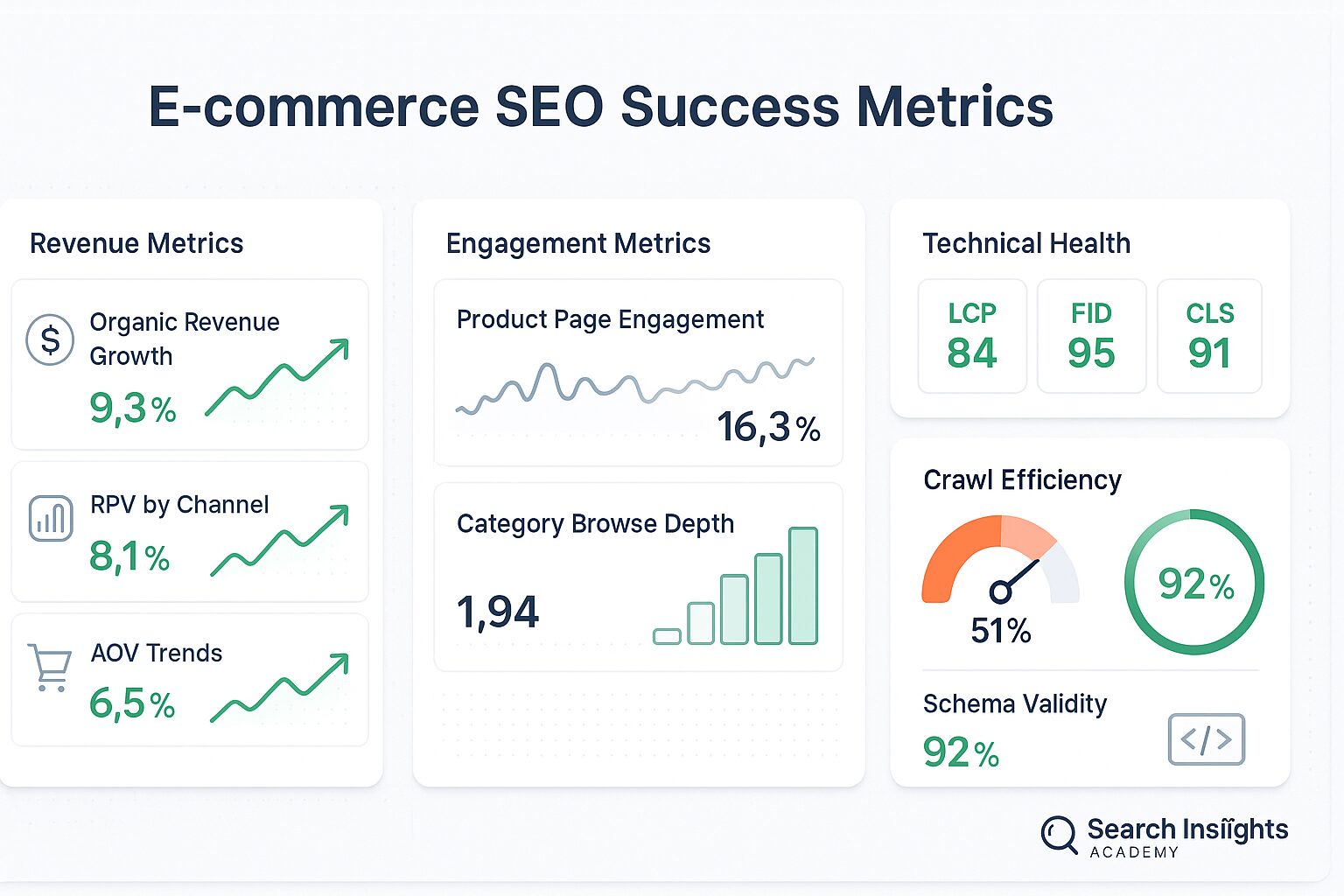
Track success using comprehensive analytics setup focusing on business outcomes:
Revenue Metrics:
- Organic revenue growth (MoM and YoY)
- Revenue per visitor (RPV) by channel
- Average order value (AOV) trends
- Customer lifetime value (CLV) from organic
- Return on SEO investment (ROAS)
Engagement Metrics:
- Product page engagement rates
- Category browse depth
- Cross-sell effectiveness
- Search refinement usage
- Mobile vs. desktop performance
Technical Health Metrics:
- Core Web Vitals by template type
- JavaScript rendering success rate
- Crawl budget efficiency
- Index coverage ratios
- Schema markup validity
Attribution Modeling
Implement sophisticated tracking to understand SEO’s full impact:
// Enhanced e-commerce tracking
gtag(‘event’, ‘view_item’, {
currency: ‘USD’,
value: 39.99,
items: [{
item_id: ‘SKU123’,
item_name: ‘Premium Running Shoes’,
item_category: ‘Footwear’,
item_category2: ‘Running’,
item_category3: ‘Men\’s’,
item_brand: ‘Nike’,
item_variant: ‘Black/Size 10’,
price: 39.99,
index: 1,
quantity: 1
}],
search_term: ‘men\’s running shoes’,
traffic_source: ‘organic’
});
Implementation Roadmap
Phase 1: Foundation (Weeks 1-2)
Your transformation begins with critical fixes:
- Audit URL structure and implement proper canonicalization
- Fix high-priority Core Web Vitals issues
- Set up Google Merchant Center integration
- Implement basic product schema markup
- Address critical crawl errors and 404s
Phase 2: Optimization (Weeks 3-6)
Build on your foundation with complex improvements:
- Design and implement faceted navigation strategy
- Optimize top 20% of category pages
- Enhance product pages with E-E-A-T signals
- Expand schema markup implementation
- Develop internal linking structure
Phase 3: Growth (Weeks 7-12)
Scale your success with content and systems:
- Launch comprehensive buying guide program
- Develop video content for key products
- Optimize for ChatGPT and AI shopping
- Build systematic link acquisition process
- Begin international SEO if applicable
Phase 4: Scale (Ongoing)
Maintain momentum with automated systems:
- Implement comprehensive monitoring
- Develop new category launch playbooks
- Test emerging search features
- Build brand authority through thought leadership
- Create proprietary tools and data
Conclusion: The Path Forward
Success in e-commerce SEO isn’t achieved through tricks or shortcuts—it’s earned through technical excellence, user focus, and relentless optimization. The sites dominating search results aren’t necessarily those with the biggest budgets or largest catalogs. They’re the ones executing fundamentals flawlessly while adapting quickly to new opportunities.
Your journey starts with fixing the basics. Clean up your URL structure to eliminate duplicate content. Solve the faceted navigation puzzle that’s likely costing you significant traffic. Optimize for both traditional search and emerging AI-powered shopping experiences. Build category pages that demonstrate genuine expertise. Create product pages that convert through comprehensive optimization that serves both search engines and shoppers.
Remember that e-commerce SEO is a compound game. Every technical improvement builds on the last. Every optimized image, fixed crawl error, and enhanced product description contributes to a stronger foundation. The sites you compete against likely have years of accumulated optimizations—but they’re also likely carrying years of technical debt. Your opportunity lies in building correctly from the start or fixing comprehensively during your optimization process.
The convergence of AI, voice search, visual search, and traditional SEO creates complexity but also opportunity. While your competitors struggle to adapt their legacy implementations, you can build for the future while excelling at today’s requirements. Start implementing these strategies now, and watch your organic traffic—and more importantly, your revenue—transform.
The future of e-commerce belongs to those who master both technical excellence and user experience. Make sure that’s you.

